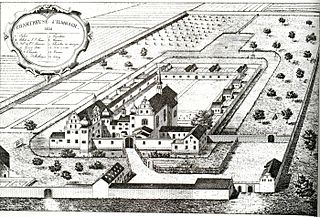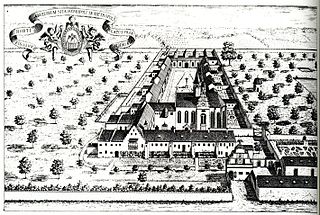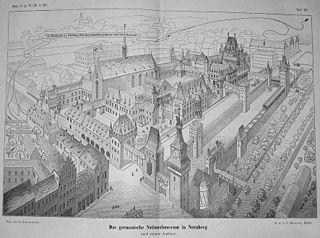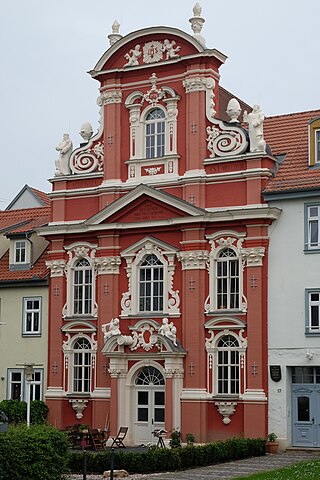
Hildesheim Charterhouse (German : Kartause Hildesheim, Kartause Marienkloster; Latin : Domus Claustri Beatae Mariae) is a former Carthusian monastery or charterhouse in Hildesheim in Lower Saxony, Germany.

Hildesheim Charterhouse (German : Kartause Hildesheim, Kartause Marienkloster; Latin : Domus Claustri Beatae Mariae) is a former Carthusian monastery or charterhouse in Hildesheim in Lower Saxony, Germany.
The charterhouse was founded by Gerhard vom Berge (or von Berg), bishop of Hildesheim from 1365 to 1398, in thanks for his victory over Magnus I, Duke of Brunswick-Lüneburg, in the battle of Dinklar. The deed of foundation was executed on 2 May 1388. The first monks were from Erfurt Charterhouse. [1] The monastery premises were built to begin with outside the town of Hildesheim, in front of the Dammtor (a gate to the new suburb of Dammstadt) to the west of the town, on land belonging to the von Rössing family where the Bennoburg fortress had previously stood. The charterhouse did not become the full owner of the ground on which it stood until 1448. [2]
On 20 June 1522 inhabitants of Hildesheim set fire to the monastery during the Hildesheim Diocesan Feud. In 1542 the town council introduced the Protestant Reformation and after repeated looting of the charterhouse in 1542 and 1542 the monks, under their prior Dietrich Loher (c.1495–1554), withdrew to Cologne. When in 1543 Loher was appointed prior of Buxheim Charterhouse near Memmingen in Upper Swabia, several of the Hildesheim monks accompanied him.
On 30 July 1545 the monastery was plundered yet again. The documents and the contents of the treasury were taken over by the town council. Parts of the buildings were used for town defence. Only in 1613 were the Carthusians able to reoccupy the premises. On 23 July 1626, during the Thirty Years' War, Danish troops and inhabitants of Hildesheim destroyed the monastery. The ruins were completely demolished in 1632.
| Hildesheim about 1750 | |||
|---|---|---|---|
| The old charterhouse (1388–1632) | The new charterhouse (1659–1777) | ||
Under Prince-Bishop Maximilian Henry of Bavaria the monastery was re-established inside the town walls in 1659–1660 for its better protection, between the cathedral close and the Langelinienwall.
In 1708 Bernhard Aly, an assimilated Ottoman prisoner of war (German : Beutetürke ), entered the monastery. Aly, who at his baptism took the surname "Weissenburg" after the German name of his home town, Belgrade, was still evidenced in the monastery in 1758 under his Carthusian name Pater Josephus. [3]
In 1777 the monastery was dissolved, after the Prince-Bishop of Hildesheim Friedrich Wilhelm von Westphalen, in agreement with Pope Pius VI and Emperor Joseph II, assigned its assets and estate to the improvement of the income of the Hildesheim seminary. [4] The monks were transferred to various other monasteries. The last prior, Carl Unkraut (1731–1823), moved to Vogelsang Charterhouse near Jülich, where he became prior in 1796 and remained until its suppression in 1802. [5]
Part of the monastery library was acquired by Hildesheim Cathedral library. The buildings were used firstly as a seminary and later as a poorhouse and charity school. [6] On 11 June 1852 the bishop of Hildesheim, Eduard Jakob Wedekin, opened in the "Karthaus", as the south wing of the secularised charterhouse was called, the St. Bernward Hospital (St. Bernward Krankenhaus), which still exists.
The last visible structural trace of the charterhouse is the Baroque gateway in the Neue Straße, now part of the St. Bernward Hospital, with figures of the Madonna in glory, Saint John the Baptist and Saint Bruno of Cologne, the founder of the Carthusian Order, standing on pedestals above it.

Mauerbach Charterhouse, in Mauerbach on the outskirts of Vienna, Austria, is a former Carthusian monastery, or charterhouse. Founded in 1314 and rebuilt in the 17th and 18th centuries, the Baroque monastic complex is one of the most important structures of its kind in Austria. Since 1984 the former charterhouse has been undergoing restoration by the Austrian Federal Monuments Office, which has its workshops there.
Marienehe Charterhouse, also sometimes referred to as Rostock Charterhouse, was a Carthusian monastery, or charterhouse, in Marienehe, now a suburb of Rostock in Mecklenburg-Vorpommern, Germany.
Eppenberg Charterhouse was a charterhouse, or Carthusian monastery, now a ruin, situated on the Eppenberg next to the Heiligenberg in Gensungen, now part of Felsberg in Hesse, Germany. It was established to replace a failing monastery of Premonstratensian canonesses.

Ilmbach Charterhouse, also Mariengarten Charterhouse, is a former Carthusian monastery, or charterhouse, in Prichsenstadt in Bavaria, Germany.

Grünau Charterhouse is a former Carthusian monastery, or charterhouse, in Schollbrunn in Bavaria, Germany. It was the first Carthusian monastery in Franconia and in today's Bavaria.

Astheim Charterhouse, also known as Marienbrück Charterhouse, was a Carthusian monastery, or charterhouse, in Astheim near Volkach in Kitzingen, Bavaria, Germany.

Freiburg Charterhouse is a former Carthusian monastery, or charterhouse, in Freiburg im Breisgau, Baden-Württemberg, Germany.

Engelgarten Charterhouse or Würzburg Charterhouse is a former Carthusian monastery, or charterhouse, in Würzburg in Bavaria, Germany.

Marienau Charterhouse is a Carthusian monastery, or charterhouse, the successor to the Maria Hain Charterhouse in Düsseldorf, located since 1964 in Marienau, a part of Bad Wurzach, district of Ravensburg in Baden-Württemberg. It is the only extant Carthusian monastery in Germany.

Cologne Charterhouse was a Carthusian monastery or charterhouse established in the Severinsviertel district, in the present Altstadt-Süd, of Cologne, Germany. Founded in 1334, the monastery developed into the largest charterhouse in Germany until it was forcibly dissolved in 1794 by the invading French Revolutionary troops. The building complex was then neglected until World War II, when it was mostly destroyed. The present building complex is very largely a post-war reconstruction. Since 1928, the Carthusian church, dedicated to Saint Barbara, has belonged to the Protestant congregation of Cologne.

Nuremberg Charterhouse was a Carthusian monastery, or charterhouse, in Nuremberg in Germany. Its surviving premises are now incorporated into the Germanisches Nationalmuseum.

The Bernward Monument is a larger-than-life-sized bronze statue of Bishop Bernward of Hildesheim in the Domhof in Hildesheim. It was made by Ferdinand Hartzer in 1893 for the nine hundredth anniversary of St. Bernward's enthronement as Bishop of Hildesheim. On 7 September 2011, in the course of the renovations of Hildesheim Cathedral it was temporarily relocated to the garden of house 24, Domhof.

Eisenach Charterhouse is a former charterhouse, or Carthusian monastery, in Eisenach in Thüringia, Germany, founded in 1378 and suppressed in 1525.

Frankfurt Charterhouse was a Carthusian monastery or charterhouse in Frankfurt an der Oder in Brandenburg, Germany.

Erfurt Charterhouse is a former charterhouse, or Carthusian monastery, in Erfurt, Thuringia, Germany. It was founded in the 1370s: building works began in 1372 and the monastery was accepted into the Carthusian Order in 1374. Work started on the church in 1375.

Vogelsang Charterhouse was a Carthusian monastery or charterhouse near Jülich in the present North Rhine-Westphalia, Germany, founded in 1478 and secularised during the mediatisation of Germany in 1802.

Güterstein Charterhouse was a Carthusian monastery in the Swabian Alb near Bad Urach, Baden-Württemberg, Germany.

Koblenz Charterhouse was a Carthusian monastery, or charterhouse, in Koblenz, Rhineland-Palatinate, Germany. It stood on the Beatusberg, a hill that forms the north-easterly tip of the Hunsrück overlooking the city. The site was first occupied by a Benedictine monastery, the Kloster St. Beatusberg, which was closed in 1315, when the monks were replaced by a community of Augustinian Canons until the Carthusians took over the site in 1331.

Mainz Charterhouse is a former Carthusian monastery, or charterhouse, in Mainz, Rheinland-Pfalz, Germany, demolished in 1790–1792 but still marked by the street-name "Karthaus".